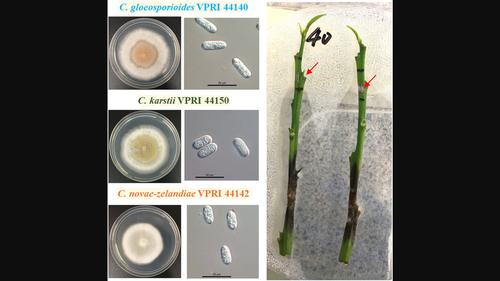当前位置:
X-MOL 学术
›
Plant Pathol.
›
论文详情
Our official English website, www.x-mol.net, welcomes your
feedback! (Note: you will need to create a separate account there.)
Identification and pathogenicity of Colletotrichum species associated with twig dieback of citrus in Western Australia
Plant Pathology ( IF 2.3 ) Pub Date : 2024-03-04 , DOI: 10.1111/ppa.13888 Weixia Wang 1 , Andrew S. Taylor 2 , Eden Tongson 1 , Jacqueline Edwards 3 , Niloofar Vaghefi 1 , Peter K. Ades 1 , Pedro W. Crous 4 , Paul W. J. Taylor 1
Plant Pathology ( IF 2.3 ) Pub Date : 2024-03-04 , DOI: 10.1111/ppa.13888 Weixia Wang 1 , Andrew S. Taylor 2 , Eden Tongson 1 , Jacqueline Edwards 3 , Niloofar Vaghefi 1 , Peter K. Ades 1 , Pedro W. Crous 4 , Paul W. J. Taylor 1
Affiliation

|
Up to 32 Colletotrichum species have been reported to be associated with pre‐ or postharvest diseases of citrus globally, while in Australia, six species have been reported to cause citrus leaf and fruit disease. Twig or shoot dieback has recently been observed as an emerging disease in citrus orchards in Western Australia. Colletotrichum species were isolated from diseased twigs showing dieback (withertip) or lesions, with or without gummosis, collected from 12 varieties of orange, mandarin and lemon. Colletotrichum gloeosporioides sensu stricto, Colletotrichum karstii and Colletotrichum novae‐zelandiae were identified using a polyphasic approach that included multigene phylogenetic analysis using sequences of internal transcribed spacer and intervening 5.8S nrDNA (ITS), glyceraldehyde‐3‐phosphate dehydrogenase (gapdh ), β‐tubulin (tub2 ), actin (act ) and histone (his3 ) for isolates in the boninense species complex, and Apn2–Mat1–2 intergenic spacer and partial mating type (Mat1–2) (ApMat ) and glutamine synthetase (gs ) for isolates in the gloeosporioides species complex, as well as morphological characteristics. C. gloeosporioides was the most prevalent species associated with twig dieback in Western Australia, while C. novae‐zelandiae was reported for the first time in Australia. Pathogenicity tests on shoot twigs from lemon and orange trees confirmed C. gloeosporioides , C. karstii and C. novae‐zelandiae as the cause of twig dieback, with C. gloeosporioides being the most aggressive species. Knowledge of the species causing twig dieback and their lifestyle will assist the development of integrated control methods.
中文翻译:

与西澳大利亚柑橘枝枯病相关的炭疽菌属物种的鉴定和致病性
最多 32 个炭疽菌属 据报道,全球范围内有 6 个物种与柑橘采前或采后病害有关,而在澳大利亚,有 6 个物种据报道会引起柑橘叶部和果实病害。最近在西澳大利亚柑橘园中观察到小枝或枝条顶枯病是一种新出现的疾病。炭疽菌属 这些物种是从 12 个橙子、柑橘和柠檬品种中采集的显示枯萎(枯萎)或病变(有或没有流胶)的患病树枝中分离出来的。炭疽菌 严格意义,喀斯特炭疽菌 和新泽兰炭疽菌 使用多相方法进行鉴定,包括使用内部转录间隔序列和插入的 5.8S nrDNA (ITS)、甘油醛-3-磷酸脱氢酶的多基因系统发育分析(间隙 ), β-微管蛋白 (浴缸2 ), 肌动蛋白 (行为 ) 和组蛋白 (他的3 ) 对于博宁物种复合体中的分离株,以及 Apn2–Mat1–2 基因间间隔区和部分交配类型 (Mat1–2) (阿普马特 )和谷氨酰胺合成酶(GS )用于胶孢子菌复合体中的分离株以及形态特征。炭疽杆菌 是西澳大利亚与树枝枯死相关的最普遍的物种,而C. novae-zelandiae 澳大利亚首次报道。柠檬和橙树嫩枝的致病性测试得到证实炭疽杆菌 ,喀斯提藻 和C. novae-zelandiae 作为树枝枯死的原因,炭疽杆菌 是最具攻击性的物种。了解引起树枝枯死的物种及其生活方式将有助于综合控制方法的开发。
更新日期:2024-03-04
中文翻译:

与西澳大利亚柑橘枝枯病相关的炭疽菌属物种的鉴定和致病性
最多 32 个
















































 京公网安备 11010802027423号
京公网安备 11010802027423号